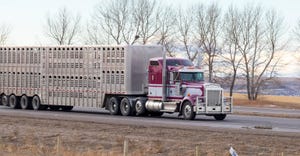Industry efforts implemented to alleviate backlog appear to have been successful.

Although it has been a topic of much debate over the past several months, two industry stakeholders said Thursday during the Global Hog Industry Virtual Conference that all signs are suggesting that there is no longer a backlog in the U.S. hog industry.
Despite pork packers in the southeastern U.S. still dealing with some challenges, Dennis Smith, commodity broker specializing in grain and livestock trading at Archer Financial, said increasing weights are confirmation that packers are worried about not having enough butcher hogs down the road for the fourth quarter.
“I try to go by not what a packer says or what China says; I try to go by what they do and what their behavior is,” he said. “We have seen so much that is completely off the charts this year. I’ve been getting phone calls from my clients that the sow slaughter packers have been calling around looking for sows to slaughter.”
In other words, he said they are willing to expand hours to kill more sows if they can get the numbers to kill.
Packer behavior is revealing that there is a concern about really tight supplies of product between now and the Chinese Lunar New Year, Smith said.
“I don’t think there is a backlog. We just aren’t picking it up from any sources, whether it’s from my sources in the eastern hog belt or my sources in the western or my people up in northern Minnesota,” he said.
In fact, he said he’s hearing the opposite.
During November, the industry normally has a heavy fall run that challenges the slaughter capacity, along with heavier weights and product backups.
“We’re just not seeing that on the horizon at all,” Smith said.
A lot of this, he explained, has to be attributed to euthanizing baby pigs and -- probably more so -- to aborted sows.
“The timing would be about right from when this activity was likely taking place as far as when that happened versus the butcher hog supply in the November/December time frame,” Smith said.
David Bauer, senior market analyst at Provimi/Cargill, also believes the U.S. industry is current in the marketplace.
“I hear more people talking more about the packer looking for hogs; they’re making sure that they have the pounds of pork," Bauer said.
China, China, China
Regarding China, Smith said the country has bought a record-large amount of pork this year, at 683,000 metric tons, and 127,000 mt still has to ship this year.
“What they’re saying is that pork supply at the end of this year will be up 30% versus last year,” he said.
Additionally, they are saying that third-quarter pork production will be up 18%, but Smith said this is in comparison to the third quarter a couple years ago in which there was a large drop in production.
As to whether China is out of the woods, Smith said 2019 pork production was at a 16-year low, and total production is expected to be lower again in 2020.
“Regardless of what they say, the cash hog price in China right now is somewhere around $204.50/cwt. That's compared with the U.S. hog market somewhere around $65.00/cwt. On a carcass basis, you’re talking about a $280 hog carcass in China right now on the cash market,” he said.
Even as China is trying to convince the world that all is well, Smith said he is hearing whispers that there is real concern about food shortages in China.
“Policies are in place to try to conserve consumption and eliminate food waste in China,” he said.
Refrain from expansion
In a year that has been far from normal and full of challenges, Smith said he hopes the hog industry refrains from any type of expansion and let prices do their job.
“What I mean by that is let rising and higher prices begin to ration this thing out — ration out the available supply of pork, and let profits run for a period of time,” he said.
He explained that, two years ago, China was not the largest buyer of U.S. pork, and it probably won’t be the largest buyer of pork two years from now, either.
“This is a real opportunity to let profits run in the industry. We just kind of started getting to profitability. I’m assuming it’s going to stay that way, and I would hate to see any sort of a blip toward expansion again in the next one or two ‘Hogs & Pigs’ reports,” Smith said.
Market recap
December live cattle futures were sharply lower this week. Contracts closed lower Monday at $105.15/cwt. and Thursday at $103.475/cwt.
November feeder cattle futures also saw large losses. Contracts closed lower Monday at $130.075/cwt. and Thursday at $130.425/cwt.
The Choice and Select cutouts closed lower at $208.86/cwt. and $191.08/cwt., respectively.
February lean hog futures were lower for most of the week. Contracts closed Monday at $70.85/cwt. and Thursday at $66.85/cwt.
The pork cutout was mixed this week. The wholesale pork cutout closed higher at $98.84/cwt. Loins closed lower at $83.07/cwt., while hams were higher at $97.14/cwt. Bellies were higher at $174.34.
Hogs delivered to the western Corn Belt were nearly unchanged from last week, closing at $64.48/cwt.
The U.S. Department of Agriculture reported the Eastern Region whole broiler/fryer weighted average price at 65.17 cents/lb. on Oct. 16.
According to USDA, egg prices were steady, with a steady to weak undertone. Supplies were mostly moderate, and offerings were light. Demand was light to fairly good.
Large eggs delivered to the Northeast were unchanged at $1.10-1.14/doz. Prices in the Southeast and Midwest were also unchanged at $1.14-1.17/doz. and $1.02-1.05/doz., respectively. Large eggs delivered to California were higher at $1.79/doz.
For turkeys, USDA said the market was steady to firm, and demand was moderate to good. The price range for hens was $1.14-1.20/lb., and the price range for toms was unchanged at $1.14-1.19/lb.
About the Author(s)
You May Also Like





